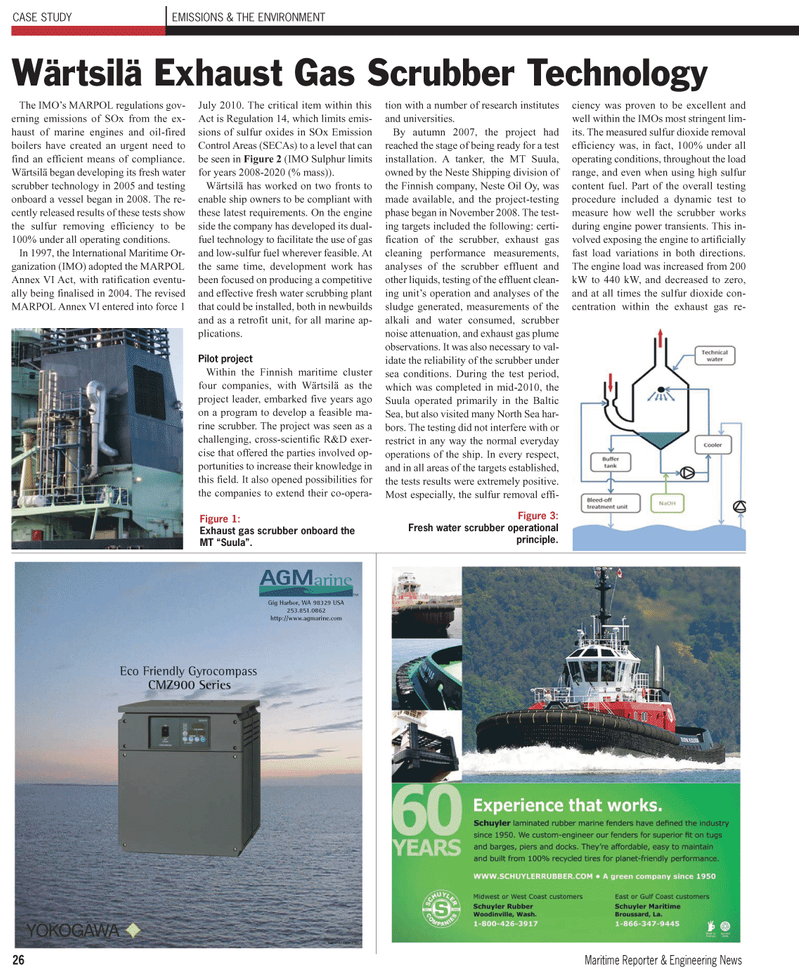
Page 26: of Maritime Reporter Magazine (December 2010)
Great Ships of 2010
Read this page in Pdf, Flash or Html5 edition of December 2010 Maritime Reporter Magazine
26 Maritime Reporter & Engineering News
The IMO’s MARPOL regulations gov- erning emissions of SOx from the ex- haust of marine engines and oil-fired boilers have created an urgent need to find an efficient means of compliance.
Wärtsilä began developing its fresh water scrubber technology in 2005 and testing onboard a vessel began in 2008. The re- cently released results of these tests show the sulfur removing efficiency to be 100% under all operating conditions.
In 1997, the International Maritime Or- ganization (IMO) adopted the MARPOL
Annex VI Act, with ratification eventu- ally being finalised in 2004. The revised
MARPOL Annex VI entered into force 1
July 2010. The critical item within this
Act is Regulation 14, which limits emis- sions of sulfur oxides in SOx Emission
Control Areas (SECAs) to a level that can be seen in Figure 2 (IMO Sulphur limits for years 2008-2020 (% mass)).
Wärtsilä has worked on two fronts to enable ship owners to be compliant with these latest requirements. On the engine side the company has developed its dual- fuel technology to facilitate the use of gas and low-sulfur fuel wherever feasible. At the same time, development work has been focused on producing a competitive and effective fresh water scrubbing plant that could be installed, both in newbuilds and as a retrofit unit, for all marine ap- plications.
Pilot project
Within the Finnish maritime cluster four companies, with Wärtsilä as the project leader, embarked five years ago on a program to develop a feasible ma- rine scrubber. The project was seen as a challenging, cross-scientific R&D exer- cise that offered the parties involved op- portunities to increase their knowledge in this field. It also opened possibilities for the companies to extend their co-opera- tion with a number of research institutes and universities.
By autumn 2007, the project had reached the stage of being ready for a test installation. A tanker, the MT Suula, owned by the Neste Shipping division of the Finnish company, Neste Oil Oy, was made available, and the project-testing phase began in November 2008. The test- ing targets included the following: certi- fication of the scrubber, exhaust gas cleaning performance measurements, analyses of the scrubber effluent and other liquids, testing of the effluent clean- ing unit’s operation and analyses of the sludge generated, measurements of the alkali and water consumed, scrubber noise attenuation, and exhaust gas plume observations. It was also necessary to val- idate the reliability of the scrubber under sea conditions. During the test period, which was completed in mid-2010, the
Suula operated primarily in the Baltic
Sea, but also visited many North Sea har- bors. The testing did not interfere with or restrict in any way the normal everyday operations of the ship. In every respect, and in all areas of the targets established, the tests results were extremely positive.
Most especially, the sulfur removal effi- ciency was proven to be excellent and well within the IMOs most stringent lim- its. The measured sulfur dioxide removal efficiency was, in fact, 100% under all operating conditions, throughout the load range, and even when using high sulfur content fuel. Part of the overall testing procedure included a dynamic test to measure how well the scrubber works during engine power transients. This in- volved exposing the engine to artificially fast load variations in both directions.
The engine load was increased from 200 kW to 440 kW, and decreased to zero, and at all times the sulfur dioxide con- centration within the exhaust gas re-
CASE STUDY EMISSIONS & THE ENVIRONMENT arine
TM
CMZ900 Series
Gig Harbor, WA 98329 USA 253.851.0862 http://www.agmarine.com
Eco Friendly Gyrocompass
Copywrite 2000~2007
Wärtsilä Exhaust Gas Scrubber Technology
Figure 1:
Exhaust gas scrubber onboard the
MT “Suula”.
Figure 3:
Fresh water scrubber operational principle.

 25
25

 27
27
